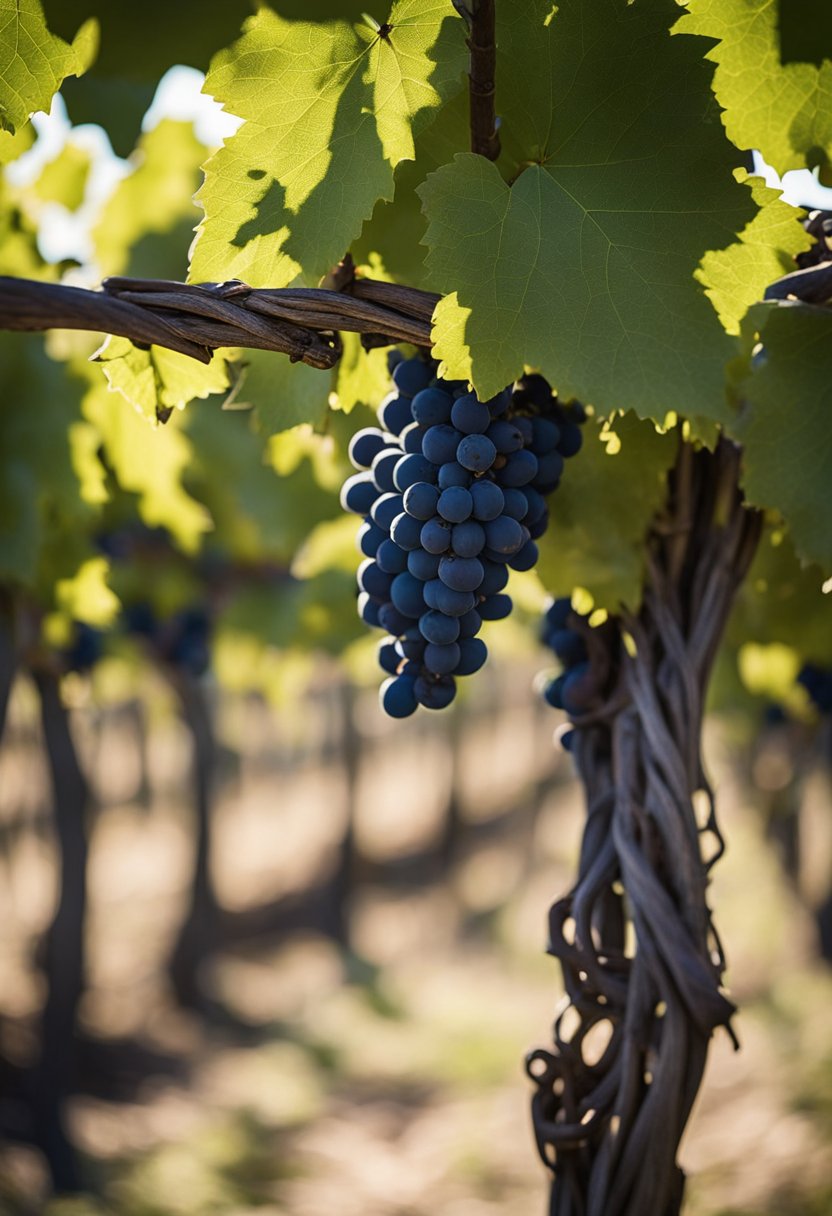If you’re a home gardener who loves growing grapes, you know that pruning is an essential part of the process. Learning how to prune grapes helps to control the growth of your grape vines, encourages fruit production, and keeps your plants healthy.
This post may contain affiliate links.
But if you’re new to pruning grapes, it can be a daunting task. Where do you start? How do you know which parts of the plant to cut back? In this article, we’ll walk you through the basics of pruning grapes so that you can feel confident in your abilities.
First, it’s important to understand why pruning is necessary. Grapevines are vigorous growers, and if left unchecked, they can become tangled masses of foliage that produce little fruit.
Related Article: Growing Grapes on a Trellis
Pruning helps to channel the plant’s energy into the parts of the vine that will produce the best fruit, while also allowing for good air circulation and sunlight penetration.
By removing old or damaged wood, you’ll also help to prevent disease and pests from taking hold. In short, pruning is essential for the health and productivity of your grapevines.
Related Article: Growing Grapes from Cuttings: A Beginner’s Guide
Understanding Grapevine Structure
Grapevine structure is composed of various parts that play a crucial role in the growth and development of the plant. Understanding the structure of grapevines is essential for successful pruning.
Identifying Grapevine Parts
The grapevine trunk is the main stem that supports the plant and serves as its lifeline. It is the central structure from which all other parts of the grapevine grow. The trunk is usually trained to grow upright, and it can be thick and woody with rough bark.

Grapevine shoots are young, green stems that grow from the trunk. They are flexible and can be trained to grow in different directions. As the shoots mature, they develop into canes that are thicker and woody.
Grapevine arms are horizontal branches that grow from the trunk and support the fruiting canes. Spurs are short, woody branches that grow from the arms and produce fruiting canes.
Related Article: Growing Grapes on a Fence
Fruiting canes are the long, woody branches that grow from the spurs and produce grapes. They are usually pruned back to a few buds to promote fruit production.
Growth Cycles and Dormancy
Grapevines go through different growth cycles throughout the year. During the dormant season, which lasts from late fall to early spring, the grapevine is not actively growing. This is the best time to prune grapevines because the plant is less susceptible to damage and disease.
In the spring, as the weather warms up, grapevines begin to grow new shoots and leaves. This is the time when the grapevine is most vulnerable to damage from pruning.
During the summer, grapevines continue to grow and produce fruit. It is important to maintain the structure of the grapevine during this time to ensure proper fruit production.
Understanding the structure of grapevines and their growth cycles is crucial for successful pruning. By identifying the different parts of the grapevine and understanding their functions, you can prune your grapevines effectively and promote healthy growth and fruit production.
Related Article: Growing Grapes in Pots: Tips and Tricks for Successful Container Gardening
Pruning Fundamentals
Pruning is a crucial aspect of grapevine management that involves the removal of unwanted or dead parts of the plant. This process helps to maintain the health of the grapevine and improve the quality of the fruit. In this section, we will discuss the fundamentals of pruning grapevines.
Why Prune Grapevines?
Pruning grapevines is essential for maintaining vine health and maximizing fruit production. Pruning helps to remove dead or diseased wood, improve airflow, and promote the growth of new shoots. It also helps to regulate the crop load and control the size and shape of the vine.
When to Prune
Winter is the best time to prune grapevines when they are dormant. This is because the plant is less susceptible to damage during this period, and pruning during this time helps to promote the growth of new shoots in the spring.
It is recommended to prune grapevines annually to maintain their health and productivity.
Related Article: Grape Jelly Canning Recipe: Easy and Delicious
Tools for Pruning
There are various tools used for pruning grapevines, including loppers, pruning shears, bypass pruners, and saws.
Loppers and pruning shears are ideal for cutting smaller branches, while saws are best for cutting larger branches. When selecting pruning tools, it is essential to choose high-quality tools that are comfortable to use and easy to maintain.
Pruning grapevines is a vital aspect of grapevine management that should be done annually during the winter months.
Using the right tools, such as loppers, pruning shears, and saws, can help make the process easier and more efficient. By following these pruning fundamentals, you can maintain the health of your grapevine and improve the quality of your fruit.
Pruning Techniques
When it comes to pruning grapes, there are three main techniques you can use: cane pruning, spur pruning, and renewal spurs and fruiting wood. Each technique has its own benefits and drawbacks, so it’s important to understand them all before you start pruning your grapevines.
Cane Pruning
Cane pruning is a technique that involves removing the previous year’s growth and leaving one or two healthy canes on the vine.
This technique is best for vigorous vines and grape varieties that produce a lot of fruit. Cane pruning helps to balance the vine’s growth and production, as well as encourage new growth for the following year.
To cane prune your grapevines, follow these steps:
- Identify the two healthiest canes on the vine.
- Cut off all other growth from the previous year.
- Cut back the two canes to 8-12 buds.
- Tie the canes to the trellis or support wire.
Spur Pruning
Spur pruning is a technique that involves leaving a short section of the previous year’s growth on the vine, known as a spur. This technique is best for productive grapevines that need to be maintained and balanced. Spur pruning helps to promote fruit production and maintain the vine’s shape.
To spur prune your grapevines, follow these steps:
- Identify the spurs from the previous year’s growth.
- Cut back the spurs to 2-3 buds.
- Remove any dead or damaged wood.
- Tie the spurs to the trellis or support wire.
Renewal Spurs and Fruiting Wood
Renewal spurs and fruiting wood are two important parts of grapevine pruning. The renewal spurs are sections of wood that are left on the vine to promote new growth, while fruiting wood is where the grapes will grow.
It’s important to maintain a balance between renewal spurs and fruiting wood to ensure a productive vine.
To maintain the balance between renewal spurs and fruiting wood, follow these steps:
- Identify the renewal spurs from the previous year’s growth.
- Cut back the renewal spurs to 2-3 buds.
- Identify the fruiting wood from the previous year’s growth.
- Cut back the fruiting wood to 2-3 buds.
- Remove any dead or damaged wood.
- Tie the renewal spurs and fruiting wood to the trellis or support wire.
By using these pruning techniques, you can maintain a healthy and productive grapevine. Remember to always use a sharp pruning cut and to remove any new growth that is not needed. With a little bit of practice, you’ll be able to prune your grapevines like a pro!
Training and Supporting Grapevines
When it comes to grapevine pruning, training and supporting the vines is crucial for healthy growth and maximum yield.
There are two main systems for training and supporting grapevines: trellis and arbor systems. Additionally, tying and training methods are important for ensuring the vines grow in the desired direction.
Trellis and Arbor Systems
Trellis systems are the most common method for training grapevines. They consist of a series of horizontal wires supported by posts.
The vines are trained to grow along the wires, with the permanent trunk and cordon (the main horizontal stem) running along the bottom wire and the lateral arms (the side branches) growing along the higher wires.
Arbor systems are similar to trellis systems, but the wires are supported by overhead beams instead of posts. This creates a shaded area underneath the vines, which can be a great spot for relaxing or entertaining.
Tying and Training Methods
To ensure the vines grow in the desired direction, tying and training methods are used. One common method is to tie the lateral arms to the trellis wires using soft twine or plastic clips. This helps to keep the arms in place and prevents them from sagging.
Another method is to use a cane-pruning system, where the previous year’s growth is tied to the trellis wires and allowed to grow along them. This can be a good method for young vines, as it encourages vigorous growth.
Overall, proper training and support is essential for healthy grapevine growth and maximum yield. By using a trellis or arbor system and tying and training the vines, you can ensure your grapevines are healthy and productive for years to come.
Maintaining Vine Health and Vigor
Balancing Growth and Fruit Production
Pruning your grapevines is crucial to maintaining vine health and vigor. It is important to balance the amount of vegetative growth with the amount of fruit production.
Too much vegetative growth can lead to excessive shading, which can reduce the amount of sunlight that reaches the fruiting zone. This can result in poor fruit quality and reduced yields. On the other hand, too much fruit production can weaken the vine and reduce its overall vigor.
To achieve a balance between vegetative growth and fruit production, it is recommended that you prune your grapevines in the winter or early spring. This will encourage the growth of new shoots, which will produce fruit in the coming season.
You should aim to leave a few buds on each cane to ensure that there is enough fruiting wood for the following season.
Preventing Common Diseases
Disease can be a major threat to the health and vigor of your grapevines. To prevent diseases, it is important to keep your vineyard clean and free of debris. This will help to reduce the risk of fungal and bacterial infections.
It is also important to provide your grapevines with adequate sunlight and nutrients, as this will help to promote healthy growth and photosynthesis.
To prevent diseases, you should also consider applying fertilizer to your grapevines. This will help to provide your vines with the necessary nutrients to grow and produce fruit. It is important to use a balanced fertilizer that contains nitrogen, phosphorus, and potassium, as well as other micronutrients.
In addition to these measures, it is important to monitor your grapevines for signs of disease. If you notice any unusual symptoms, such as yellowing leaves or wilting vines, you should take action immediately.
This may involve removing infected vines or applying fungicides to prevent the spread of disease.
By following these tips, you can maintain the health and vigor of your grapevines and enjoy a bountiful harvest each season.
Frequently Asked Questions
When is the best time of year to prune grape vines?
The best time to prune grape vines is in late winter or early spring when they are still dormant. It’s important to prune before the buds start to swell, as this can cause bleeding and weaken the vine.
What are the proper techniques for pruning grape vines in the winter?
When pruning grape vines in the winter, it’s important to remove any dead, diseased or damaged wood. You should also remove any shoots that are growing from the base of the vine and any shoots that are growing in the wrong direction. You should aim to leave around 3-4 buds on each cane.
How can I prune grape vines on a trellis effectively?
When pruning grape vines on a trellis, it’s important to train the vines to grow along the trellis wires. You should also remove any shoots that are growing from the base of the vine and any shoots that are growing in the wrong direction. You should aim to leave around 3-4 buds on each cane.
Can improper pruning of grape vines lead to their death?
Improper pruning of grape vines can weaken the vine and make it more susceptible to disease. However, it’s unlikely to lead to the death of the vine unless it is severely neglected.
What are the consequences of not pruning grape vines at all?
If grape vines are not pruned at all, they can become overgrown and produce fewer grapes. This can also make the vine more susceptible to disease and pests.
How can pruning affect the size of the grapes produced?
Pruning can affect the size of the grapes produced by controlling the amount of fruit the vine produces.
By pruning back the vine, you can encourage it to produce fewer, but larger grapes. However, it’s important not to over-prune, as this can stress the vine and reduce its overall health.
Learn more about growing grapes on Pinterest.




